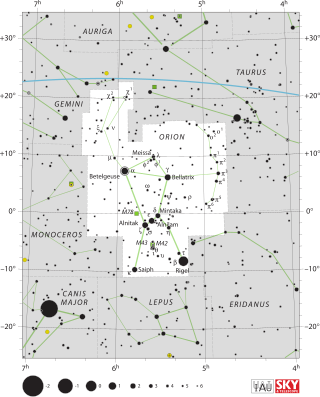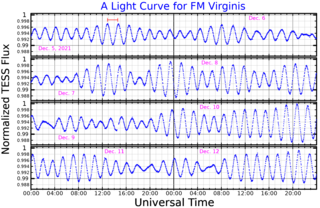Xi Scorpii is part of a quintuple star system in the constellation Scorpius. It was assigned this designation by Bayer, although Ptolemy had catalogued the star in Libra. Flamsteed assigned it the designation 51 Librae, but this has fallen out of use since modern constellation boundaries assign the star to Scorpius.

Epsilon Volantis, Latinized from ε Volantis, is a quadruple star system in the southern constellation Volans. This star is at the center of the constellation of Volans and connects the "wings" of the constellation. Based upon parallax measurements, is roughly 640 light years from Earth.

9 Andromedae, abbreviated 9 And by convention, is a variable binary star system in the northern constellation Andromeda. 9 Andromedae is the Flamsteed designation, while it bears the variable star designation AN Andromedae, or AN And. The maximum apparent visual magnitude of the system is 5.98, which places it near the lower limit of visibility to the human eye. Based upon an annual parallax shift of 7.1 mas, it is located 460 light years from the Earth.

4 Cassiopeiae is a red giant in the northern constellation of Cassiopeia, located approximately 790 light-years away from the Sun. It is visible to the naked eye as a faint, red-hued star with a baseline apparent visual magnitude of 4.96. At the distance of this system, its visual magnitude is diminished by an extinction of 0.56 due to interstellar dust. This system is moving closer to the Earth with a heliocentric radial velocity of −39 km/s.
3 Centauri is a triple star system in the southern constellation of Centaurus, located approximately 300 light years from the Sun. It is visible to the naked eye as a faint, blue-white hued star with a combined apparent visual magnitude of 4.32. As of 2017, the two visible components had an angular separation of 7.851″ along a position angle of 106°. The system has the Bayer designation k Centauri; 3 Centauri is the Flamsteed designation. It is a suspected eclipsing binary with a variable star designation V983 Centauri.

HD 93250 is a highly luminous hot blue binary star in the Carina Nebula in the constellation Carina.

ET Andromedae is a binary star system star in the northern constellation of Andromeda. It has an apparent visual magnitude of 6.48, placing it at the nominal limit for visibility with the naked eye. The distance to this system can be estimated from its annual parallax shift of 5.42 mas, which yields a value of 602 light years.

V1472 Aquilae is a triple star system in the equatorial constellation of Aquila. It is a variable star that ranges in brightness from 6.36 down to 6.60. The system is located at a distance of approximately 780 light years from the Sun based on parallax. It is a high-velocity star system with a radial velocity of −112 km/s.

LY Aurigae is a multiple star system in the constellation Auriga. It is an eclipsing binary variable star, dropping in brightness by 0.7 magnitudes every 4 days. The system is around a thousand light years away in the Auriga OB1 stellar association.

S Monocerotis, also known as 15 Monocerotis, is a massive multiple and variable star system located in the constellation Monoceros. It is the brightest star in the Christmas Tree open cluster in the area catalogued as NGC 2264.

AX Circini is a binary star system in the southern constellation of Circinus. It has a nominal magnitude of 5.91, which is bright enough to be visible to the naked eye. Based upon an annual parallax shift of 1.7 mas, it is located roughly 1,900 light-years from the Earth. The system is moving closer with a heliocentric radial velocity of −21 km/s.

RR Ursae Minoris, abbreviated RR UMi, is a binary star system in the northern circumpolar constellation of Ursa Minor. It can be viewed with the naked eye, typically having an apparent visual magnitude of around 4.710. Based upon an annual parallax shift of 10.0 mas as seen from Earth's orbit, it is located 330 light years away. The system is moving further from the Sun with a heliocentric radial velocity of +6 km/s.
HD 3322 is a binary star system in the northern constellation of Andromeda. With an apparent visual magnitude of 6.51, it lies below the nominal brightness limit for visibility with the normal naked eye, but it is still possible to see the star with excellent vision under ideal seeing conditions. An annual parallax shift of 4.59±0.65 mas provides a distance estimate of roughly 700 light years.
V1309 Scorpii is a contact binary that merged into a single star in 2008 in a process known as a luminous red nova.It was the first star to provide conclusive evidence that contact binary systems end their evolution in a stellar merger. Its similarities to V838 Monocerotis and V4332 Sagittarii allowed scientists to identify these stars as merged contact binaries as well.

HD 53367 is a triple star system in the constellation of Monoceros. The primary star was identified as a variable Herbig Ae/Be star in 1989. Its companion, spectroscopically discovered in 2006, is a pre-main-sequence star star with an average separation of 1.7 AU. The star system is embedded in the extended nebula IC 2177.

RS Sagittarii is an eclipsing binary star system in the southern constellation of Sagittarius, abbreviated RS Sgr. It is a double-lined spectroscopic binary with an orbital period of 2.416 days, indicating that the components are too close to each other to be individually resolved. The system has a combined apparent visual magnitude of 6.01, which is bright enough to be faintly visible to the naked eye. During the primary eclipse the brightness drops to magnitude 6.97, while the secondary eclipse is of magnitude 6.28. The distance to this system is approximately 1,420 light years based on parallax measurements.

HD 40372, also known as 59 Orionis, V1004 Orionis and HR 2100, is a variable star in the constellation Orion. Its apparent magnitude varies between magnitude 5.88 and 5.92, making it faintly visible to the naked eye for an observer far from light polluted urban areas. HD 40372 exhibits two types of variability; it is an eclipsing binary star and one of the two stars is a Delta Scuti variable star.

HD 224355, also known as V1022 Cassiopeiae, HR 9059 and Boss 6148, is an eclipsing binary star in the constellation Cassiopeia. It ranges in apparent magnitude from 5.57 to 5.68, which means it is faintly visible to the naked eye for an observer located well away from city lights. It is one of the few binaries known to be an astrometric, spectroscopic and eclipsing binary, a combination that allows the parameters of the stellar system to be calculated with high accuracy. HD 224355 lies 16′ west of the 5th-magnitude σ Cassiopeiae.

32 Virginis, also known as FM Virginis, is a star located about 250 light years from the Earth, in the constellation Virgo. Its apparent magnitude ranges from 5.20 to 5.28, making it faintly visible to the naked eye of an observer well away from city lights. 32 Virginis is a binary star, and the more massive component of the binary is a Delta Scuti variable star which oscillates with a dominant period of 103.51 minutes.

HD 149404, also known as HR 6164 and V918 Scorpii, is a star about 4,300 light years from the Earth, in the constellation Scorpius. It is a 5th magnitude star, so it will be faintly visible to the naked eye of an observer far from city lights. It is a rotating ellipsoidal variable, a binary star for which the two stars' combined brightness varies slightly, from magnitude 5.42 to 5.50, during their 9.8 day orbital period. It is one of the brightest members of the Ara OB1 association, which has the open cluster NGC 6193 at its center.
















